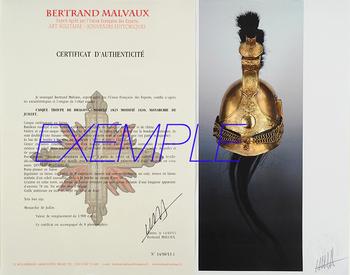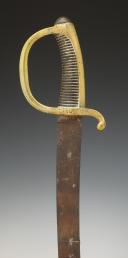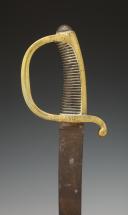
INFANTRY TROOP SABER KNOWN AS A "BRIQUET", model An XIII, July Monarchy. 30067
Sold out
INFANTRY TROOP SABER KNOWN AS "BRIQUET", model An IX, July Monarchy. 30067
Solid brass hilt with a single-branched guard stamped with "PDL" (Property of the State). Handle with 28 strands, molded quillon. Slightly curved flat blade, length 59.3 cm.
France.
July Monarchy.
Poor condition, guard in good condition, blade oxidized with dents. Without scabbard.
NOTE:
THE END OF A LEGEND "PDL" STAMP ON NATIONAL GUARD WEAPONS
Many searches have not allowed me to find any citation that could confirm the reality of this motto "Pour le droit" (For the right). So what is it? What is the National Guard? The National Guard was created during the Revolution. It is a militia tasked with maintaining order and respect for the law in troubled times. It is made up of all citizens aged 20 to 60. They are listed and classified for service, either in reserve or active duty. Initially, the National Guards were mostly bourgeois as they were required to equip themselves at their own expense, and to be in the cavalry, one needed to have a horse. For the bourgeois, this role was a way to maintain a form of power, to distinguish themselves from the rest of the citizen population. The National Guards are spread throughout all municipalities. They serve as the "Police" under the orders of a commanding officer, the mayor, and the prefect. During the Empire, the National Guard sometimes acted as a reserve army and was mobilized for Napoleon's wars. After Charles X dissolved the National Guards in 1827, Louis Philippe reconstituted them in 1830. There would be a company in each municipality, forming infantry, artillery, cavalry, and even firefighters. The National Guard was reactivated to put an end to disturbances and maintain peace throughout France after the July Revolution.
Marking of the weapons with PDL in 1831
By the end of 1830, the Minister wanted to bring order to the National Guards. He aimed to organize the troops and ordered the retrieval and registration of weapons distributed earlier during the July Revolution. A document from the archives of the city of Lyon dated August 10, 1830, confirms this. In January 1831, a ministerial circular decided to stamp the weapons distributed by the Ministry of War and owned by the state. These would be stamped with a mark "PDL" denoting "Property of the State," as seen in a document from January 20, 1831, from the prefecture to the Lyon archives. This marking was done using a punch circulating from village to village within each canton. The stamping process was carried out in the presence of the assembled National Guards by the mayors and commanders. The punch would remain the property of the main town of the canton, allowing for future markings to be conducted. A report would be drawn up, signed by the mayor, and sent to the prefecture.
It is noted that the National Guards' weapons were very diverse. They consisted of rifles, sabers, cartridge boxes, and other military-type equipment and uniforms often privately made, differing somewhat from standard models. These were acquired by the Guards themselves as well as by the municipalities. Additionally, there were standard weapons furnished to the municipalities through the Ministry of War. It was only this latter category of state-owned equipment that the Ministry aimed to mark to verify ownership and prevent the dispersal of weapons. An excerpt from the January 1831 circular reproduces the printed notice attached to the punch intended for the municipalities, detailing the method to be used for stamping rifles. The same circular mentions the creation, with the approval of the Minister of the Interior, of an armament manual for the National Guards.
In 1848, following the February revolution and the establishment of the Second Republic, a decree reactivated the National Guard in March. The front page of the "Courrier de la Drome et de l'Ardèche" on October 29, 1848, No. 224, shows that identical measures as in 1831 (still in force) were taken with the registration of the National Guards and their weapons. The "PDL" marking of state-owned weapons was reaffirmed. Furthermore, it was forbidden for private gunsmiths to convert National Guard weapons to percussion, in order to avoid a proliferation of available calibers.
The "PLD" stamp
The mark in the wood created by stamping a blackened metal imprint presented these three letters PDL. For a long time, they have been interpreted as standing for the motto "Pour Le Droit" (For The Right), which seems to have no basis. These documents show that it simply serves to indicate "Property of the State." The rooster located at the top recalls a symbol of the nation that was highlighted by Louis Philippe upon his arrival to power in 1831. This stamp can be found on the stocks of pistols and standard rifles used by the National Guard, typically 1816 or 1822 model pistols, and often the corrected An IX 1777 model rifles. The Ministry of War provided obsolete weapons to the National Guard, reserving the recent 1822 models for the military, and later on the 1822 T and Tbis models.
Solid brass hilt with a single-branched guard stamped with "PDL" (Property of the State). Handle with 28 strands, molded quillon. Slightly curved flat blade, length 59.3 cm.
France.
July Monarchy.
Poor condition, guard in good condition, blade oxidized with dents. Without scabbard.
NOTE:
THE END OF A LEGEND "PDL" STAMP ON NATIONAL GUARD WEAPONS
Many searches have not allowed me to find any citation that could confirm the reality of this motto "Pour le droit" (For the right). So what is it? What is the National Guard? The National Guard was created during the Revolution. It is a militia tasked with maintaining order and respect for the law in troubled times. It is made up of all citizens aged 20 to 60. They are listed and classified for service, either in reserve or active duty. Initially, the National Guards were mostly bourgeois as they were required to equip themselves at their own expense, and to be in the cavalry, one needed to have a horse. For the bourgeois, this role was a way to maintain a form of power, to distinguish themselves from the rest of the citizen population. The National Guards are spread throughout all municipalities. They serve as the "Police" under the orders of a commanding officer, the mayor, and the prefect. During the Empire, the National Guard sometimes acted as a reserve army and was mobilized for Napoleon's wars. After Charles X dissolved the National Guards in 1827, Louis Philippe reconstituted them in 1830. There would be a company in each municipality, forming infantry, artillery, cavalry, and even firefighters. The National Guard was reactivated to put an end to disturbances and maintain peace throughout France after the July Revolution.
Marking of the weapons with PDL in 1831
By the end of 1830, the Minister wanted to bring order to the National Guards. He aimed to organize the troops and ordered the retrieval and registration of weapons distributed earlier during the July Revolution. A document from the archives of the city of Lyon dated August 10, 1830, confirms this. In January 1831, a ministerial circular decided to stamp the weapons distributed by the Ministry of War and owned by the state. These would be stamped with a mark "PDL" denoting "Property of the State," as seen in a document from January 20, 1831, from the prefecture to the Lyon archives. This marking was done using a punch circulating from village to village within each canton. The stamping process was carried out in the presence of the assembled National Guards by the mayors and commanders. The punch would remain the property of the main town of the canton, allowing for future markings to be conducted. A report would be drawn up, signed by the mayor, and sent to the prefecture.
It is noted that the National Guards' weapons were very diverse. They consisted of rifles, sabers, cartridge boxes, and other military-type equipment and uniforms often privately made, differing somewhat from standard models. These were acquired by the Guards themselves as well as by the municipalities. Additionally, there were standard weapons furnished to the municipalities through the Ministry of War. It was only this latter category of state-owned equipment that the Ministry aimed to mark to verify ownership and prevent the dispersal of weapons. An excerpt from the January 1831 circular reproduces the printed notice attached to the punch intended for the municipalities, detailing the method to be used for stamping rifles. The same circular mentions the creation, with the approval of the Minister of the Interior, of an armament manual for the National Guards.
In 1848, following the February revolution and the establishment of the Second Republic, a decree reactivated the National Guard in March. The front page of the "Courrier de la Drome et de l'Ardèche" on October 29, 1848, No. 224, shows that identical measures as in 1831 (still in force) were taken with the registration of the National Guards and their weapons. The "PDL" marking of state-owned weapons was reaffirmed. Furthermore, it was forbidden for private gunsmiths to convert National Guard weapons to percussion, in order to avoid a proliferation of available calibers.
The "PLD" stamp
The mark in the wood created by stamping a blackened metal imprint presented these three letters PDL. For a long time, they have been interpreted as standing for the motto "Pour Le Droit" (For The Right), which seems to have no basis. These documents show that it simply serves to indicate "Property of the State." The rooster located at the top recalls a symbol of the nation that was highlighted by Louis Philippe upon his arrival to power in 1831. This stamp can be found on the stocks of pistols and standard rifles used by the National Guard, typically 1816 or 1822 model pistols, and often the corrected An IX 1777 model rifles. The Ministry of War provided obsolete weapons to the National Guard, reserving the recent 1822 models for the military, and later on the 1822 T and Tbis models.
Reference :
30067

Next update Friday, december 12 at 13:30 PM
FOR ALL PURCHASES, PAYMENT IN MULTIPLE CHECKS POSSIBLE
bertrand.malvaux@wanadoo.fr 06 07 75 74 63
SHIPPING COSTS
Shipping costs are calculated only once per order for one or more items, all shipments are sent via registered mail, as this is the only way to have proof of dispatch and receipt.
For parcels whose value cannot be insured by the Post, shipments are entrusted to DHL or Fedex with real value insured, the service is of high quality but the cost is higher.
RETURN POLICY
Items can be returned within 8 days of receipt. They must be returned by registered mail at the sender's expense, in their original packaging, and in their original condition.
AUTHENTICITY
The selection of items offered on this site allows me to guarantee the authenticity of each piece described here, all items offered are guaranteed to be period and authentic, unless otherwise noted or restricted in the description.
An authenticity certificate of the item including the description published on the site, the period, the sale price, accompanied by one or more color photographs is automatically provided for any item priced over 130 euros. Below this price, each certificate is charged 5 euros.
Only items sold by me are subject to an authenticity certificate, I do not provide any expert reports for items sold by third parties (colleagues or collectors).
FOR ALL PURCHASES, PAYMENT IN MULTIPLE CHECKS POSSIBLE
bertrand.malvaux@wanadoo.fr 06 07 75 74 63
An authenticity certificate of the item including the description published on the site, the period, the sale price, accompanied by one or more color photographs is automatically provided for any item priced over 130 euros. Below this price, each certificate is charged 5 euros.
Only items sold by me are subject to an authenticity certificate, I do not provide any expert reports for items sold by third parties (colleagues or collectors).



